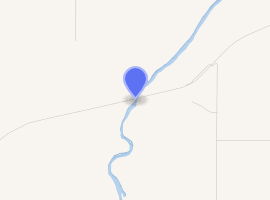Fabyan Trestle Bridge
The Battle River Railway Trestle, commonly known as the Fabyan Trestle Bridge, was constructed between 1907-December 10, 1908 west of Fabyan, Alberta, Canada at the cost of $600,000.[1]
Fabyan Trestle Bridge | |
|---|---|
| Coordinates | 52°52′36″N 111°03′27″W |
| Carries | Railway |
| Crosses | Battle River |
| Locale | Fabyan |
| Official name | Battle River Railway Trestle |
| Maintained by | Canadian National Railway |
| Characteristics | |
| Total length | 845.82 metres (2,775.0 ft) |
| Height | 59.44 metres (195.0 ft) |
| History | |
| Construction start | 1907 |
| Construction end | December 10, 1908 |
| Opened | January 1909 |

| |
Overview
The steel trestle was designed by the Grand Trunk Pacific railway as part of the company's westward movement to Edmonton. With the Battle River valley meandering west to east, a bridge had to be built in order to continue the westward trek, with its current location the most viable.
Upon completion, it was the largest railway structure in Canada until the Lethbridge Viaduct was completed in August 1909.
History
In 1907, the concrete footings of the bridge were poured. With the help of local farmers and other contractors, supplies were hauled in by wagons from Hardisty until construction began on the eastern side of the valley where supplies could be delivered by rail.
After its completion, the first train to cross over was the one being used to build it, while the first transportation train to cross was in January 1909.
Specifications
- Length: 845.82 m (2,775 ft)
- Height: 59.44 m (195 ft)
Notable incidents
Construction deaths
During construction, three men died when their scow became swamped mid-stream. A cairn was later placed in their memory by their fellow workers.
Derailment
On January 21, 2012, 31 of a 137 car CN train going from Winnipeg to Edmonton derailed approximately halfway across the bridge. Of the 31 cars, 17 of them carrying wheat and barley fell to the valley below.[2] CN originally reported that all of the cars were grain cars, however, requests made by the local government official revealed that dangerous goods were also being hauled, but they did not derail.[3]
References
- "Battle River Railway Trestle". Archived from the original on 26 January 2012. Retrieved 27 February 2012.
- "17 rail cars fall off trestle bridge". Star News. 21 January 2012. Archived from the original on 15 September 2012. Retrieved 2 March 2012.
- "TSB confirms dangerous goods were part of derailed train". Star News. 2 March 2012. Archived from the original on 18 September 2012. Retrieved 2 March 2012.
See also
| Wikimedia Commons has media related to Battle River Railway Trestle. |